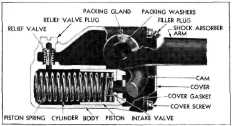1942 - 1947 CHEVROLET SHOP MANUAL
Section 2 - Frame
|
|
|||
|
2-6 |
|||
|
|
|||
|
might cause the shank of the
bolt to stretch.
A
specially heat-treated bolt, part number 376125, having dimensions of 3/8"-24 x
3/4", should be used for this
installation. Part number 120369, nut should also be
used.
Where the
equipment and personnel is available the cross members may be spot welded
to the frame side members for
additional rigidity.
Electric arc welding is preferable to acetylene welding for this
operation.
Install
the battery carrier, and rear brake hose bracket using bolts having dimension
of 5/16"-24 x 13/16",
part No. 352814. The nut is
listed under part No.
121917.
12. To reassemble the front suspension, rear
suspension, brakes and
wheels, reverse the disassembly instructions.
NOTE—It is necessary to
bleed the brakes because the hydraulic
line was opened.
13. Check the frame assembly for alignment; any
corrections needed would be
slight. After the alignment of the frame has been checked,
replace the body bolts
and adjust; reverse chassis
sheet metal disassembly instructions.
Left Side-
The
installation of a frame side member on the left side of a car is the same as described
for the installation of the
right frame side member, with the following
exceptions:
1. It is not necessary to disconnect the rear
brake pipe, gasoline pipe or
battery and carrier.
2. It is necessary to disconnect the muffler
support bracket, and tail
pipe bracket. Disconnect the
steering gear assembly from the pitman arm, frame side member, and instrument
panel so that the assembly can
be pushed up toward the
body.
SHOCK ABSORBERS
Shock
absorbers provide a smoother ride for the occupants of a car by dampening
the spring vibrations as the car
passes over irregularities in the road. There are two types of shock
absorbers used on Chevrolet
passenger cars and trucks; single-acting hydraulic and double-acting hydraulic.
The double-acting shock absorbers dampen the motion of both REBOUND and COMPRESSION of the
car springs. The single-acting
shock absorber dampens the
motion of car spring on REBOUND ONLY.
Double-acting shock
absorbers are standard equipment, both
front and rear on Chevrolet passenger Cars and are special equipment on
all com- |
merical
and truck models. Single-acting shock absorbers are standard equipment front and
rear on 1/2 and all
3/4-ton trucks, with exception of the rear on the 3/4-ton long Wheelbase
panel.
SINGLE-ACTING SHOCK ABSORBER
The
single-acting shock absorber is the most simple in construction of any used. A
cut-away view of the external
relief valve single-acting shock absorber is shown in Fig. 6. The body is of
cast iron and houses the
various parts as shown. A steel arm is securely attached to the shaft and a
packing gland and washers are
used around this shaft with a
suitable seal provided. Inside the body and pressed on the same shaft is the cam which
actuates the piston when the arm is moved. Since the piston must be
returned to its normal position after a displacement, a spring is provided under the
piston for this
purpose. |
||
 |
|||
|
Fig. 6-Single-Acting Shock Absorber
An intake
valve is mounted in the piston and its function is to replenish fluid in
the cylinder as the piston returns to
its normal position. The reservoir consists of all the space in the shock
absorber body outside of the
cylinder which holds the piston and piston spring. A relief valve is located
between the cylinder and the
reservoir to relieve any excess pressure which may be created by
sudden or rapid movement of the
piston. This valve is easily accessible by removing the relief valve
plug or nut. The open end of
the shock absorber body is covered by a stamped steel cover plate and gasket. This
cover is held in place by
screws. Removing either the filler plug or relief valve permits filling
or adding fluid.
The shock
absorber body is mounted rigidly to the car frame side member while the arm is
connected to a fitting on the car axle.
Operation
When the
wheels strike a bump, the car springs compress and the car frame moves downward,
carrying the shock absorber
with it. This causes the shock absorber arm to move upward,
relieving the cam pressure on the
piston. Relieving this |
|||
|
|
|||